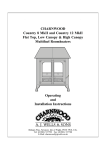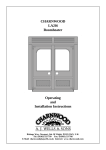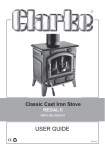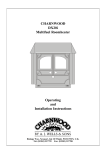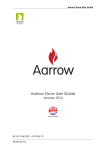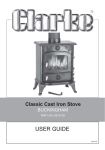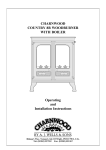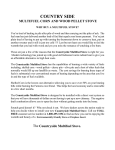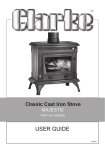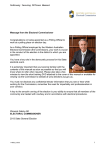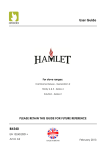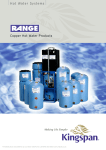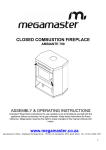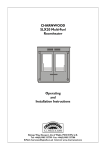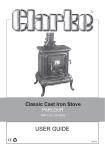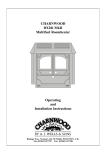Download Multifuel Backboiler Inset Stove
Transcript
Multifuel Backboiler Inset Stove Instruction Manual All the comfort of a stove with the benefit of heat to your house. INDEX Page 1.0INTRODUCTION ......................................................................................... 1 2.0 IMPORTANT SAFETY NOTES ............................................................... 1 3.0 TERMS & CONDITIONS OF GUARANTEE ...................................... 2 4.0 Installation INSTRUCTIONS 4.1Performance ..................................................................................... 3 4.2 Health and Safety ........................................................................... 4 4.3 Air Supply .......................................................................................... 4 4.4Fireplace ............................................................................................. 4 4.5Hearth ................................................................................................. 5 4.6Chimney/Flue .................................................................................. 5 4.7 Installing and Back Filling ......................................................... 6 4.8 Heating and Hot Water System ............................................... 9 4.9 System Controls .............................................................................. 9 4.10 Checks Before Lighting ................................................................ 9 4.11Commissioning............................................................................... 9 5.0 OPERATING INSTRUCTIONS 5.1Fuels ..................................................................................................... 10 5.2 Lighting and Controlling ............................................................ 10 5.2.1 Wood ...................................................................................... 10 5.2.2 Smokeless Fuel ................................................................... 11 5.3 Overnight Burning ......................................................................... 11 5.4 Clearance of Ash ............................................................................. 12 5.5 Throat Plate (Baffles) .................................................................... 12 5.5.1 Initial Burning ..................................................................... 12 5.5.2 Regular Checking .............................................................. 12 6.0MAINTENANCE 6.1Cleaning ............................................................................................. 12 6.2 Door Seals .......................................................................................... 12 6.3 When Not in Use ............................................................................. 12 6.4 Chimney Cleaning ......................................................................... 12 6.5 Chimney Fires ................................................................................... 13 6.6 Fume Emission ................................................................................ 13 6.7Servicing ............................................................................................ 13 7.0 TROUBLE SHOOTING............................................................................... 13 1.0INTRODUCTION We would like to thank you for purchasing a high efficiency, Firebird multifuel backboiler inset stove (hereinafter referred to as “the inset stove”). The design for this product stems from our original concept, “the Firebird backboiler”. The stove is manufactured in its entirety in our factory in Baile Mhic Íre, Macroom, Co. Cork, using the highest standard of workmanship and latest technology. This instruction manual has been produced for the reference and guidance of qualified installation technicians. You should ensure that all installation, servicing and commissioning works are carried out by a competent person. It should be noted that it is the responsibility of the installer/ householder to ensure that the inset stove is properly commissioned. Failure to do so may invalidate the warranty. 2.0 IMPORTANT SAFETY NOTES • The term multifuel refers to commercially available solid fuels such as wood, smokeless coal and anthracite. Liquid fuels should never be used when lighting or filling the fire. • THIS INSET STOVE SHOULD ONLY BE INSTALLED IN OPEN VENTED SYSTEMS. • Do not store liquid fuels in close proximity to the inset stove. • The inset stove is designed in such a way, that under normal burning conditions, the fumes pass up through the chimney flue and do not escape into the home. Please ensure that the flue system is checked regularly, that no cracks or openings are evident and that the seals on the inset stove are in good condition. • ENSURE THE BAFFLES ARE ALWAYS IN PLACE WHEN LIGHTING THE INSET STOVE AND NEVER LIGHT A FIRE IF THE BAFFLES ARE NOT IN PLACE. • THE INSET STOVE DOOR SHOULD NOT BE KEPT OPEN WHEN THE FIRE IS LIT/ BURNING. • The inset stove should never be over stocked/over filled. The draught settings should be reduced if this occurs. • A mechanical air supply should never be added to the inset stove. • The inset stove reaches high temperatures and can be hot to touch. Ensure that safety guards (in accordance with BS6539) are in place. • Do not place any furniture or combustible material within 800mm of the inset stove. • Please read this manual carefully prior to installation of the inset stove. • Installation of the inset stove, must conform to Building Regulations at all times. 1 3.0 TERMS & CONDITIONS OF GUARANTEE • This Firebird product is designed and manufactured to give many years of trouble-free service. We provide a comprehensive warranty of 5 years on the inset stove. • The warranty will only apply if the inset stove is installed by a competent person and is serviced annually thereafter. • The following terms, laid out in the guarantee must be adhered to: (a) All claims under the guarantee must be received within 5 years from the date of installation, provided installation has occurred within 12 months from date of purchase. (b)The inset stove must be installed and commissioned by a competent person and as set out in this instruction manual. (c) Maintenance should be carried out at the intervals outlined in this manual. (d)Installation of the inset stove must be in accordance with this manual and all relevant standards and codes of practice. (e) Firebird can accept no liability in respect of any defect arising from incorrect installation, negligence, fair wear and tear, misuse, alteration or repair by unqualified persons. (f ) The guarantee extends to reasonable labour costs except under clause (a), where any valid claim made after 3 years will not include labour costs. (g)Firebird’s prior authorisation must be obtained before examination or repair of the inset stove takes place. (h)Firebird will examine all claims made under the guarantee and for any claims deemed invalid, costs incurred will be borne by the householder. (i) The inset stove must be used for domestic heating purposes only. (j) Any defective part removed under any or all of the guarantees, MUST be returned to Firebird. THE STATUTORY RIGHTS OF THE HOUSEHOLDER ARE NOT AFFECTED BY THIS GUARANTEE 2 4.0 INSTALLATION INSTRUCTION 4.1PERFORMANCE The following highlights the output and test performance of the inset stove: Firebird 16” Multifuel Backboiler Inset Stove Fuel Type Wood Ancit Ancit Output to Water - kW 7.3 8.3 7.2 Output to Space - kW 2.5 3.6 0.2 Efficiency - % 75.0 79.9 81.5 CO (@13% O2) 0.61 0.36 0.44 BS Standard Test Type BS EN 13229:2001 Intermittent Intermittent Continuous Maximum water operating pressure: 3 bar. Minimum safe distance from combustible materials: sides 75mm and shelf 200mm. Firebird 18” Multifuel Backboiler Inset Stove Fuel Type Wood Ancit Ancit Output to Water - kW 6.9 12.1 7.1 Output to Space - kW 2.6 3.6 1.7 Efficiency - % 77.0 81.0 79.6 CO (@13% O2) 0.91 0.43 0.41 BS Standard Test Type BS EN 13229:2001 Intermittent Intermittent Continuous Maximum water operating pressure: 3 bar. Minimum safe distance from combustible materials: sides 75mm and shelf 200mm. Heat outputs and efficiencies are based on heat over a one hour period, using Ancit solid fuel. Outputs are obtained by independent testing to BS Standard EN 13229, burning Ancit solid fuel. The appliance is capable of intermittent operation when burning wood logs and both intermittent and continuous operation when burning smokeless fuel. 3 4.2 HEALTH AND SAFETY When installing the inset stove, please ensure that the following Health & Safety Regulations are met: • UK - Health and Safety at work Act 1974. • IRL - Safety, Health and Welfare at Work Act 2005, (Construction Regulations 2006). Installation, commissioning and/or servicing should only be carried out by a competent person. The small amounts of adhesives and sealants used in the manufacture of this appliance are cured and do not present any known hazards when used for their intended purpose. NOTE: If your Firebird inset stove is not installed, operated and maintained properly a house fire may result! 4.3 AIR SUPPLY It is essential that you provide an adequate air supply for safe and efficient operation of your inset stove. The air supply will ensure efficient combustion. Failure to do so could result in smoke filling into the room or blackening of glass. Air Requirements A permanent air entry opening or openings, with a total free area of at least 550mm2 per kW of rated output above 5kW, shall be provided. Under no circumstances should this be less than 6500mm2. If a flue draught stabiliser is fitted, then the first 5kW of rated output is 300mm2 per kW and the balance of the rated output is 850mm2 per kW. This appliance is capable of having the air supply introduced through the base. (Figure 1.) The same equation with respect to total free area must be adhered to. NOTE: No extractor fan should be fitted in the same room as the appliance. 4.4FIREPLACE When fitting into an existing fireplace, remove fireback or boiler and clear out any loose back fill material. Access from the side of the chimney breast should be made available to facilitate pipe work connections. Inset stove Air receiving zone Flexi pipe Air duct terminal fixed to wall Air duct to be fixed with wall plate at back of chimney 4 In addition, access to the front of the chimney breast may be required, via a hole, for fixing the flue pipe and back filling. 4.5HEARTH The appliance must be installed on a hearth that can take the weight and is of a non-combustible material. all installations are carried out in accordance with building regulations and manufacturer’s instructions. Always fit pipes with the narrow side down, to allow any creosote to run down the inside of the pipe. This avoids possible fire risk. Ensure that when installing the appliance, the following regulations are met: Firebird recommend that a thorough inspection of the chimney is carried out prior to installation and on a regular basis thereafter. IRL - Building Regulations 1997, Technical Guidance Document 5, states that the hearth must extend in front of the appliance by 500mm and to the sides by 150mm. The chimney should be of sound construction, free from debris, capable of withstanding extremely high temperatures and have no evidence of cracks or other faults. UK- Building regulations for class 1 appliances state that the hearth must extend in front of the appliance by 300mm and to the sides by 150mm. Best installation practice is to install a flue lining suitable for solid fuels. A rigid connection adaptor should be used to connect the flue liner to the insert stove. 4.6CHIMNEY/FLUE In order for the appliance to have sufficient draw to perform satisfactorily, a height of no less than 4.5 meters, vertically from the top of the appliance to the top of the chimney, is required. Alternatively, chimney design with sufficient draught can be calculated, in accordance with EN13384-1. Pipe bends should be kept to a minimum and there should be no more than two 45˚ bends on any installation. Do not connect the insert stove to a chimney flue which is connected to another appliance. It is essential that you use only stainless steel pipes for your inset stove and that Opening min 620 for facia Facia area min 565 max 600 The existing chimney must be checked before installing the appliance (It must be sound, free from cracks and blockages and swept). It should not have an excessive cross sectional area (greater than 250mm x 250mm square or equivalent area). Fireplace surround 16” inset - min 405 max 470 18” inset - min 455 max 520 16” inset - min 500 18” inset - min 550 for facia Limiting dimensions of surround and opening 5 Flues should not pass through ceilings, floors or any form of combustible walls without adequate, approved insulation having been installed, to protect the combustible material. 4.7 INSTALLING AND BACK FILLING 1. Remove the inset stove from its packaging and inspect for any damage. 2. Place adjustable legs to the bottom of the inset stove if required. 3. Fit the appliance into the opening, making sure it is central. A good seal should be made between the flange and the surround. The adjustable legs can be used to level the inset stove if required. 4. Remove any excess fire cement from around the flange. 5. Make the connections to the boiler and ensure the primary flow pipe rises from the boiler so that no air is trapped in the boiler. 6. Before back filling, fill the system with water and check the boiler connections for leaks. Ensure that the materials used for back filling are non-combustible. 7. An expansion pipe must be fitted to the inset stove water outlet pipe, which must be vented to atmosphere, above the height of the header tank. There should not be any valves between the inset stove and the vent pipe outlet and it must not be possible to obstruct the outlet in anyway. 8. Fit the flue connector to the top of the appliance so that it is central to the chimney and extends to the point where the chimney narrows. Ensure that the flue manufacturer’s instructions are adhered to at all times. 9. All voids must be filled and the flue pipe flaunched into the chimney, so that no soot can collect when sweeping the chimney. 10.Make good the holes in the front and side of the chimney breast, ensuring they are airtight. Remove any material from inside the appliance and check the flue pipe is clear. Fixing screws Flue liner Flexible liner Flue adaptor Flue gatherer Inset stove 6 Allow access from side of chimney breast to facilitate pipework installation Fireplace surround Inset stove X X Inset facia Fixing screws 160 130 100 60 120 40 375 140 160 60 60 375 min 415 for 16" inset min 350 mm for 18" inset min 400 mm to open door Typical installation Limiting dimensions of hearth 7 Typical schematics Open vent 22 mm Open vent 22 mm Overflow Overflow Cold water tank Feed and expansion tank Domestic hot water draw off Gravity radiator Drain cock Gravity return 28 mm Indirect hot water cylinder Gravity flow 28 mm Central heating flow Minimum return thermostat Circulating pump Back boiler Central heating return Drain cock at lowest point Injector tee Open vent 22 mm Open vent 22 mm Overflow Overflow Cold water tank Feed and expansion tank Domestic hot water draw off Gravity radiator Drain cock Gravity return 28 mm Minimum return thermostat Back boiler Indirect hot water cylinder Gravity flow 28 mm Central heating flow Circulating pump Central heating return Drain cock at lowest point 8 4.8 HEATING AND HOT WATER SYSTEM The central heating system must comply with BS5449 part 1. The hot water cylinder must be indirect and should comply with BS1566 part 1. The system must be open vented and the header tank should not be more than 12 meters above the boiler. In case of pump failure or a power cut, the system should be able to work on gravity to the hot water cylinder. In addition, the fire should be quenched, using best practice. Dumping of hot water (i.e. running hot water taps) may be required. NOTE: The system should never be valved. Depending on the size of the room into which the appliance is fitted, a radiator in the same room may give greater flexibility in operating the system and ensure sufficient heat to the room. 4.9 SYSTEM CONTROLS The system pump may not be controlled by time switches. The inset stove can be controlled with pipe thermostat. Ensure that all controls are installed to building regulations. 4.10 CHECKS BEFORE LIGHTING Note: Prior to lighting the inset stove, allow sufficient time for the back fill to dry at normal conditions. The following checks should be carried out prior to lighting a fire in the inset stove: 1. 2. 3. 4. 5. The fire grate is in place. The flue is clear. Ensure that baffles are in place. Check the door fitting. The system is full with water and vented. 6. Has a suitable inhibitor been added? 4.11COMMISSIONING Light the fire and check all joints and seals. Ensure that fumes and smoke are being taken up the chimney and no fumes are entering the room. The heating system should be balanced in accordance with best plumbing practice. Before completing the commissioning, the householder should be advised as to the operation of the inset stove and the heating controls. The instruction manual should remain with the householder. Radiators can be fitted with thermostatic or manual valves. Please note: no valves must be fitted to radiators where they act as the heat leak. 9 5.0OPERATING INSTRUCTIONS 5.1FUELS HEATAS Ltd. approval covers the burning of the following smokeless fuels in this inset stove: • Ancit. • Anthracite Large Nuts. • Centurion. • Cosycoke. • Maxibrite. • Phurnacite. • Sunbrite Doubles. • Welsh Dry Steam Coal (large nuts). • Smokeless Coal The above fuels are all suitable for smoke control areas. of time. Air dried wood should be seasoned for at least 12 months before burning. Wood that has been contaminated or treated with varnish, paint or other coatings and preservatives, should not be used. Not only does it release noxious chemicals into the air, but it can also contribute to the amount of tar and deposits building up in your chimney. NOTE: You should never over stock/over fill your inset stove. The recommended level to fill the inset stove, is up to the metal lip, as illustrated on the picture below. NOTE: Petroleum coke should never be used on this appliance. If used, it will invalidate the guarantee. Wood can be used in this appliance. The two main factors to be considered when burning wood, are the moisture content and the density. Moisture in wood will have an effect on the CV (amount of heat per unit volume), as any moisture in the wood has to be boiled away before the wood will burn. It can also create smoke and tars which could be corrosive and increase the risk of a chimney fire. Well-seasoned logs can have approximately twice the CV of unseasoned green logs. Hard wood logs are denser than soft wood logs and tend to burn for a longer period 10 Metal Lip - recommended fill level. 5.2 LIGHTING AND CONTROLLING 5.2.1WOOD NOTE: Ensure the baffles are properly installed prior to lighting the inset stove as per Figure 1 and 2 on the next page. Carry out all checks as per 4.10. Place some kindling and a firelighter on top of the grate, add some dry kindling and two to three logs. Fully open out the secondary air control (right hand side) and open the primary air control (left hand side) to about half way. See Figure 3. Light the fire and close the door. The room should be kept well ventilated on the first lighting, as there may be an odour and some smoke may be released. This is just the paint reacting to the heat and will only last for a short time. Figure 3. Figure 4. When the fire is well lit, adjust the primary and secondary air controls to give you the required level of flame. See Figure 4. For best results, wood will generally need more secondary air than primary air. Refuel the appliance when there is still a good bed of glowing embers. Place the required amount of logs on the bed, open the secondary air control fully and close the door. Once the new fuel has taken, adjust the secondary air control. Figure 1. Figure 2. 5.2.2 SMOKELESS FUEL The same applies as with wood, but you will require more primary air than secondary air with smokeless fuel. When burning Homefire or Anthracite smokeless fuel, always have the secondary air fully open on ignition. Leave it open for 3-5 minutes and adjust thereafter. 5.3 OVERNIGHT BURNING To achieve slow burning/overnight burning with smokeless coal, close the secondary air and open the primary air slightly. Please note that slow burning may cause the glass to blacken and cause sooty deposits in the flue way. Furthermore, these settings are guidelines and are dependent on the draft and fuel quality. 11 5.4 CLEARANCE OF ASH The ash pan should be emptied on a regular basis and always before it becomes too full. See Figure 5. If ash is left to build up close to the grate, it will cause damage to it. The ash pan is best emptied before you riddle the fire, when the ash is at its coolest. Check under the ash pan once a week and clean this area if necessary. See Figure 6. Ensure the bottom plate (under the ash pan) is always replaced after cleaning. 5.5 THROAT PLATE (BAFFLES) 5.5.1 INITIAL BURNING In the first month after installation, the baffles should be checked before each ignition, to establish a burning pattern to fuel type. This is necessary because some fuels deposit more soot than others. Figure 5. 5.5.2 REGULAR CHECKING Remove and clean any fly ash or soot that has built up. This should be done on a regular basis, about once a month or more as deemed necessary. 6.0MAINTENANCE 6.1CLEANING When cleaning the glass, always do so when the inset stove is cold. Abrasive cleaners or pads should never be used on the glass. For stubborn deposits, use a proprietary stove glass cleaner or ceramic hob cleaner. The front of the appliance may be wiped with a damp, lint free cloth and then dried with a dry lint free cloth. Again, make sure the appliance is cold. 6.2 DOOR SEALS Check that the seals are in good condition and in the correct place. If they are worn, they should be replaced. 6.3 WHEN NOT IN USE In the summer months or anytime that the inset stove is not being used for a long period of time, clean out the inside thoroughly and open the primary air control slightly. Figure 6. This will help to prevent condensation, and hence corrosion. 6.4 CHIMNEY CLEANING The chimney should be cleaned at least once a year and this can be done through the inset stove. Remove the throat plates (baffles) and fire bars prior to undertaking a chimney clean. 12 6.5 CHIMNEY FIRES If the instructions in this manual are followed and the chimney is cleaned once a year, chimney fires should not occur. Should the chimney go on fire, close both air intakes and ensure the door is fully closed. This should be enough to ensure the chimney fire dies. If the fire continues, then call the fire brigade. Do not open the inset stove door at any time during this period as it may cause re-ignition. Leave the door closed until the inset stove is cold. The chimney must be swept and carefully examined for damage after a chimney fire. 6.6 FUME EMISSION Fume emission is potentially dangerous. There will however be the occasional emission of fumes when opening the door to clean out ashes or filling the fire. Take the following actions immediately, if you suspect persistent fume emission: 1. Open all windows and doors to ventilate the room. 2. Let the fire go out. 3. Call professional help to find the problem and rectify it. 4. Do not light the fire until the problem is rectified. 6.7SERVICING The following is a guideline checklist which can be used during servicing. Note that other checks may be required (system dependant): - Check flue to ensure it is clear and free from soot. - Remove baffles, clean and ensure they are replaced correctly. - Check air supply to room or inset stove. Ensure that it is clean, secure and free from debris. - Ensure that all seals are in good condition. - Ensure that air wash openings are clear. 7.0 TROUBLE SHOOTING FIRE WILL NOT BURN Check that: • Primary and secondary air inlets are open with no obstructions. • Chimney and baffles are clear. • Correct fuel is being used. • Air supply to room is adequate and not blocked. FIRE NOT RESPONDING TO AIR CONTROLS/OVER BURNING Check that: • The door is fully closed. • Both air controls to the appliance are fully closed. • The door seals are in place and in good condition. • The correct fuel is being used. REDUCING BLACKENING OF GLASS This stove is designed with an air wash, the function of which is to reduce deposits on the glass. Please note that certain fuel types can cause blackening of glass. Check that: • The appliance is not being starved of air. • Bad quality fuel or damp fuel is not being used. • The balance between primary and secondary air is correct. ADVERSE WEATHER CONDITIONS Draught may be affected during bad/poor weather conditions. In this case, air adjustments may be required. 13 Ireland Northern Ireland United Kingdom FIREBIRD FIREBIRD PRODUCTS FIREBIRD UK www.firebird.ie www.firebird.ie www.firebirduk.co.uk Udaras Industrial Estate, Baile Mhic Íre, Co. Cork, Ireland. t: +353 (0)26 45253 f: +353 (0)26 45309 e: [email protected] Shean, Forkhill, Newry, BT35 9SY. t: (028) 3088 8330 f: (028) 3088 9096 e: [email protected] Central Avenue, Lee Mill Industrial Estate Nr. Ivybridge, Devon PL21 9PE t: +44 (0)1752 691177 f: +44 (0)1752 691131 e: [email protected] Photographs, Illustrations & Specifications. This catalogue was correct at the time of going to print. However, Firebird’s policy is one of continuous development. The right is reserved to change specifications, colour, and prices of the models and items illustrated and described in this publication at any time. Whilst every care has been exercised in the production of this catalogue, Firebird cannot accept any liability for errors or omissions. For the latest details always consult Firebird. MLIS002
















